Unreleased 1963 Beatles tracks hit iTunes ahead of copyright deadline
updated 4:50 PM EST, Tue December 17, 2013
STORY HIGHLIGHTS
- Releasing the songs now gives Apple records 20 more years of copyright
- Many of these Beatles tracks have circulated in bootleg fashion for decades
- The first tracks are rejects from their legendary marathon recording Abbey Road session
- Most tracks are from live BBC radio performances in 1963
If the the music sounds familiar,
you may have heard unauthorized, lesser-quality versions circulated by fans for
decades -- or similar takes on the several anthology albums released over the
years by the Beatles' label, Apple Corps.
The
59 tracks downloadable on iTunes for $40 are previously unreleased. When
John Lennon, Paul McCartney, George Harrison and Ringo Starr worked through a
dozen or more takes of a song to get one they and producer George Martin liked,
they likely hoped fans would never hear their mistakes. Some takes were so
disliked that the tapes were destroyed.
The surviving recordings became a
liability for the record label, because their copyright on unreleased material
ends on January 1, 2014. Independent labels could legally sell compilations of
rejected versions of Beatles hits.
Releasing them now gives Apple another 20 years' protection under a recent
change in European law.
The British government, following
the change in European copyright law, implemented a law last month providing
"that if a record label is not commercially releasing a track that is over 50
years old, then the performers can request that the rights in the performance
revert to them -- a 'use it or lose it' clause," the government's website
said.
Apple Corps did not comment to
CNN on the motivation for the release, but the timing of the release and their
naming it "The Beatles Bootleg Recordings 1963" suggests the connection.
No doubt many hardcore Beatles
fans around the world are bingeing on the 14 outtakes from three 1963 studio
sessions, and the 44 songs from the dozens of BBC radio shows the group
performed on when their fan base was mostly limited to the British Isles. The
album also offers two demo recordings of songs written for others.
The first Beatles Abbey
Road session
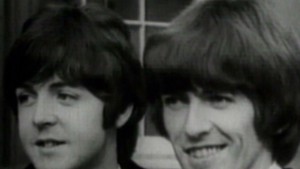 59 rare Beatles tracks
released
59 rare Beatles tracks
released
The first several tracks came
from their legendary 13-hour session with Martin on February 11, 1963.
You'll hear three full takes of
"There's a Place," the first song they recorded that fateful day at EMI Studios
in Abbey Road, London.
Some of the tracks apparently
were recorded for good measure after the group already got a take they were
satisfied with.
The new release includes the
seventh take of "Do You Want to Know a Secret," while the sixth one was released
in 1963. At the end of the take McCartney comments about the "the do-da-do bits"
in the vocal harmonies.
The sixth take of "Taste of
Honey" is included from that session. It was the fifth take with added vocals
that made it on the 1963 album.
The Beatles got only three
complete takes of "I Saw Her Standing There" out of nine attempts during that
marathon first session. One was released in 1963 and a second in a 1995
anthology project. The new release, the second take, is the third and only
previously unreleased complete version.
Two takes of "Misery" -- the
first and seventh recording that afternoon -- are included. You will not hear
Martin's piano, which was dubbed onto the final version a week later.
Abbey Road Studio: March
1963
The two tracks of "From Me to
You" offer a glimpse of the group's studio demeanor during another Abbey Road
session on March 5, 1963. They stop playing abruptly in the first take, with
Martin asking why. "I just thought I heard you talking actually. Did you
whistle? "
One Beatle to another at the end
of the second take: "Ah, you missed the ending, baby."
"George is to play the first bit
of the instrumental, isn't he?" Lennon asks before they start another take. "Key
right into the harmony."
"Thank You Girl," a song written
as a tribute to their already dedicated female groupies, is next. The new
release includes the first and fifth of 13 takes from the March session. The
song was used as a B-side on a single.
Fans can enjoy a lot of chatter
between the group on the two takes of "One After 909" in the March session.
"What are you doing?" Lennon asks another when the first take falls apart. "Are
you out of your mind?" The song was not released until the Beatles played it on
a rooftop for the 1970 "Let It Be" album.
The band seemed to struggle in
that March session with "Hold Me Tight," a song they later said they never cared
for. The bootleg project gives you take 21.
The last studio outtake on the
album is "Money (That's What I Want)," recorded on July 18, 1963.
Beatles on the BBC
1963
The next 44 tracks are from the
dozens of Beatles live appearances on BBC radio programs in 1963, including
"Saturday Club," "Easy Beat," "Here We Go," "Side By Side," "From Us To Us" and
the group's own weekly series, "Pop Go The Beatles."
Several versions of their first
big hit in England, "Love Me Do," "Taste of Honey" and "She Loves You" are
included. Some of the shows had live audiences, adding the flavor of screaming
fans. The recording quality, none in stereo, varies from show to show, since the
BBC was not trying to save the performances for later release.
The tracks include the BBC
hosts' introductions, which remind the listener of where the Beatles were in
early 1963.
"For the moment the majority of
the Beatles fans are in their hometown of Liverpool, and I have a very strong
suspicion that it won't be long before they're all over the country," the
announcer said as he introduced their performance of "Love Me Do" on the BBC's
"Easy Beat" show on January 26, 1963.
 Over the years, the facts of
the Beatles' story have sometimes been shoved out of the way by half-truths,
misconceptions and outright fiction. Here are a few details you might have
heard, with the true story provided by
Over the years, the facts of
the Beatles' story have sometimes been shoved out of the way by half-truths,
misconceptions and outright fiction. Here are a few details you might have
heard, with the true story provided by  John Lennon once said that Ringo Starr not only
wasn't the best drummer in rock, he
John Lennon once said that Ringo Starr not only
wasn't the best drummer in rock, he 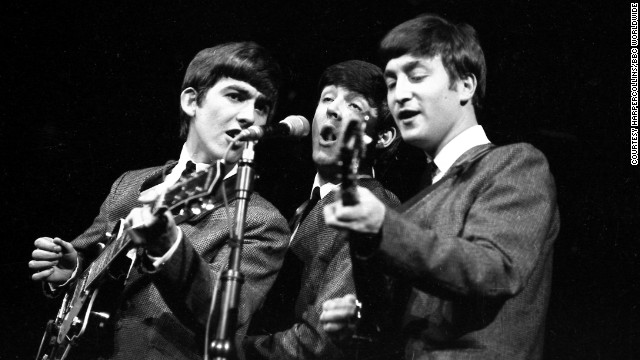 The Beatles were against wearing suits.
Again, not true, says Lewisohn. Though Lennon later trashed the neat look as a
sellout demanded by manager Brian Epstein, in the early '60s they were eager for
a change. "I just saw it as playing a game," said Harrison. "I'll wear a f******
balloon if somebody's going to pay me!" said Lennon.
The Beatles were against wearing suits.
Again, not true, says Lewisohn. Though Lennon later trashed the neat look as a
sellout demanded by manager Brian Epstein, in the early '60s they were eager for
a change. "I just saw it as playing a game," said Harrison. "I'll wear a f******
balloon if somebody's going to pay me!" said Lennon.
 They grew up poor. Not really. Harrison's
and McCartney's families were working class, and Lennon's childhood included
trips to a upscale relative's house in Scotland. Only Starr, who was also
sickly, grew up in poverty, in the blighted Dingle neighborhood.
They grew up poor. Not really. Harrison's
and McCartney's families were working class, and Lennon's childhood included
trips to a upscale relative's house in Scotland. Only Starr, who was also
sickly, grew up in poverty, in the blighted Dingle neighborhood.
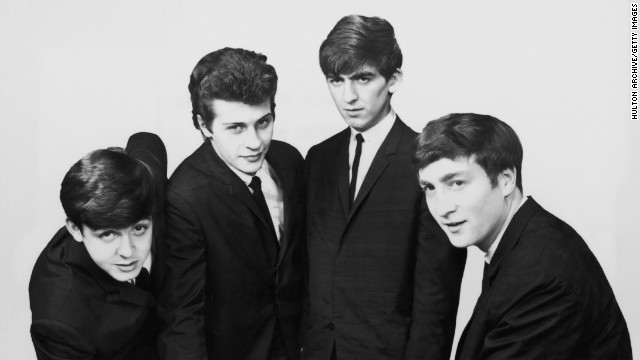 They booted drummer Pete Best out of
jealousy. Producer George Martin wasn't impressed by Best (second from
left), and McCartney has said he "was holding us back." The rest of the Beatles
were equally unsentimental. Ringo Starr, who had played with the Beatles
occasionally, was a far better drummer -- and when he joined, "from that moment
on, it gelled," said Harrison.
They booted drummer Pete Best out of
jealousy. Producer George Martin wasn't impressed by Best (second from
left), and McCartney has said he "was holding us back." The rest of the Beatles
were equally unsentimental. Ringo Starr, who had played with the Beatles
occasionally, was a far better drummer -- and when he joined, "from that moment
on, it gelled," said Harrison.
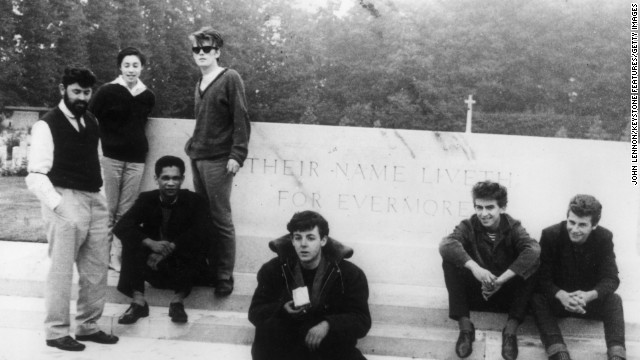 Stu Sutcliffe was a terrible bassist.
Though Sutcliffe (standing, third from left) was no McCartney, he went from
complete neophyte to solid rhythm player during the band's Hamburg days. He left
the job because he wanted to pursue his painting, and McCartney remembers being
"lumbered with" the position as new bassist.
Stu Sutcliffe was a terrible bassist.
Though Sutcliffe (standing, third from left) was no McCartney, he went from
complete neophyte to solid rhythm player during the band's Hamburg days. He left
the job because he wanted to pursue his painting, and McCartney remembers being
"lumbered with" the position as new bassist.
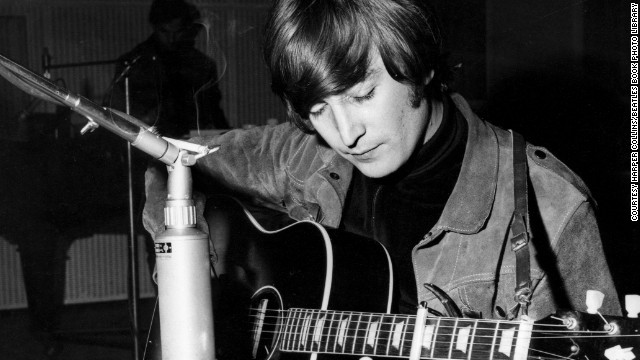 John Lennon saw his mother, Julia, killed in front
of him. Julia Dykins, as she was known after her marriage to Bobby
Dykins, died on July 15, 1958. After a chat with her sister, John's Aunt Mimi,
she went to catch a bus and was hit by a car crossing Menlove Avenue. John found
out about her death later that day.
John Lennon saw his mother, Julia, killed in front
of him. Julia Dykins, as she was known after her marriage to Bobby
Dykins, died on July 15, 1958. After a chat with her sister, John's Aunt Mimi,
she went to catch a bus and was hit by a car crossing Menlove Avenue. John found
out about her death later that day.
 The Beatles made their U.S. television debut on
"The Ed Sullivan Show," February 9, 1964. It was the band's first U.S.
television performance, but they'd already been seen on American TV during a CBS
News segment in December, 1963. Pieces from the segment also ran on Jack Paar's
talk show in January 1964.
The Beatles made their U.S. television debut on
"The Ed Sullivan Show," February 9, 1964. It was the band's first U.S.
television performance, but they'd already been seen on American TV during a CBS
News segment in December, 1963. Pieces from the segment also ran on Jack Paar's
talk show in January 1964.
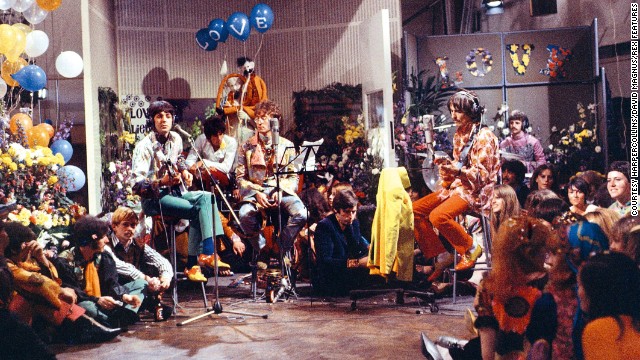 The title "Lucy in the Sky with Diamonds" is a
reference to LSD. Though its imagery of "plasticine porters" and
"kaleidoscope eyes" owes a lot to drugs (as well as John Lennon's fondness for
Lewis Carroll-esque absurdity), the song was inspired by a drawing made by
Lennon's son, Julian.
The title "Lucy in the Sky with Diamonds" is a
reference to LSD. Though its imagery of "plasticine porters" and
"kaleidoscope eyes" owes a lot to drugs (as well as John Lennon's fondness for
Lewis Carroll-esque absurdity), the song was inspired by a drawing made by
Lennon's son, Julian.
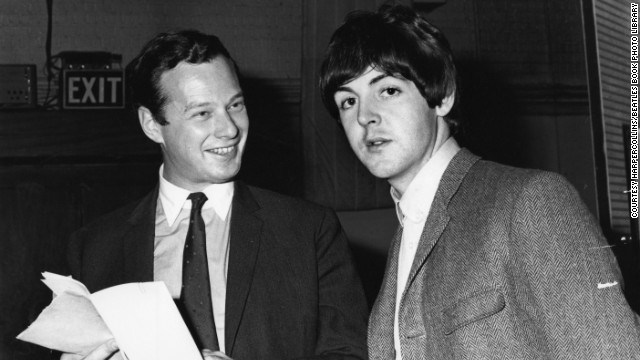 "Paul is dead." An elaborate theory --
perhaps best explained by
"Paul is dead." An elaborate theory --
perhaps best explained by  The Beatles performed on Johnny Carson's "Tonight
Show." Lennon and McCartney
The Beatles performed on Johnny Carson's "Tonight
Show." Lennon and McCartney  Yoko Ono broke up the Beatles. Oh, if
only Yoko hadn't stolen John away from the group, they would have stayed
together! Right. Actually, the Beatles were already fragmenting -- Ringo
temporarily left during the making of the White Album, and George walked out
during the "Get Back" sessions -- and financial issues were getting in the way
of the music. Lennon was ready for something new, but everybody was
tired.
Yoko Ono broke up the Beatles. Oh, if
only Yoko hadn't stolen John away from the group, they would have stayed
together! Right. Actually, the Beatles were already fragmenting -- Ringo
temporarily left during the making of the White Album, and George walked out
during the "Get Back" sessions -- and financial issues were getting in the way
of the music. Lennon was ready for something new, but everybody was
tired.












No comments:
Post a Comment